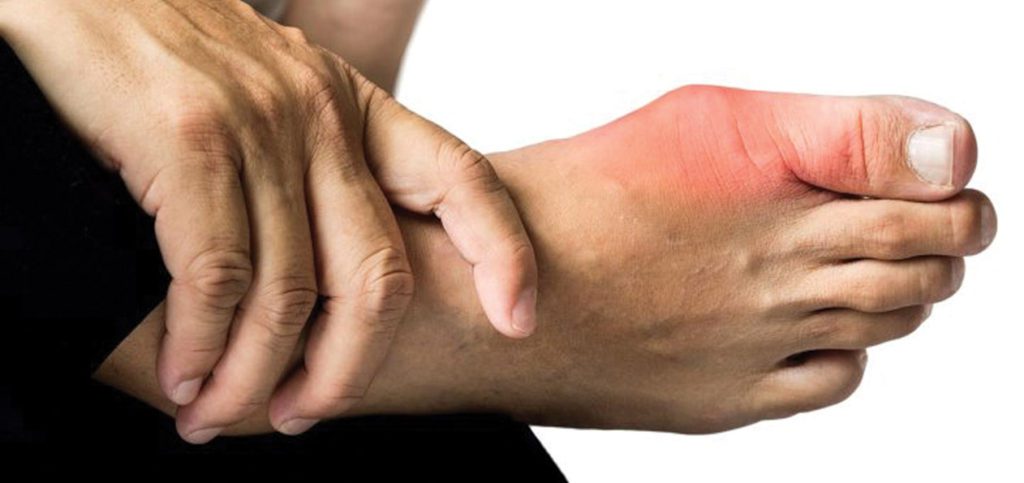Unless you or someone you know has experienced gout, you may think of it as a disease from the distant past that doesn’t get much mention today. But gout is still very much with us, and the number of Americans affected is increasing alongside the increases in obesity and other associated conditions.


“Simply stated, gout happens when excess uric acid forms into needle like crystals within a joint, and the inflammation causes swelling, redness, warmth and severe pain,” says Gary Webb, M.D. Board Certified Family Medicine Physician at Physicians Regional Medical Group. “Fortunately, gout arthritis is treatable with various anti-inflammatory medications and can be prevented by using proper routine medication, and staying hydrated. People who have elevated uric acid levels need to follow a plan developed in conjunction with their physician to keep uric acid levels down which in turn will keep them from developing gout. “
Purines are a group of chemicals present in all body tissues and in many foods. Our bodies are designed to continually process purines, breaking them down and removing the byproducts, including uric acid. Under normal conditions, excess uric acid leaves the body through urination. But in some people, the kidneys fail to excrete enough uric acid. The result is that the debris forms crystals, which can collect in various joints, or even in places like the outer ear, the skin, or the kidneys.
A 12-year, all-male study conducted by epidemiologists at Harvard, generally confirmed the stereotype of gout as a “heavy man’s disease.” Consuming large amounts of meat, soft drinks and alcohol is a direct path to gout. Those who drink two or more beers a day are more than twice as likely to develop the condition as non-beer drinkers, as beer contains a lot of purines. While gout primarily affects middle-aged and older men, postmenopausal women are also at risk due to the declining presence of protective estrogen. Those taking diuretics to control high blood pressure are also at an increased risk, as the diuretics prevent uric acid excretion in the urine.
“Recognizing gout arthritis is often overlooked by patients,” said Dr. Webb. “Elevated uric acid levels can become gout suddenly, usually presenting in one joint which becomes acutely painful. Left untreated, the joint becomes red and warm, swelling occurs, and the pain worsens which often is mistaken for infection or a traumatic injury.”
The joint at the base of the big toe is often the site of the first “gout attack,” but the knees, ankles, and many small joints of the foot are also common targets. In those already suffering from osteoarthritis, the first attack often occurs in the joints of the fingers. One of the mysteries of gout is that the attacks often subside after a couple of days, and – even without any treatment – another attack may not occur for several years, making diagnosis even trickier.
There is also a chance that the first attack will be followed by others, and the following episodes will escalate, coming on more frequently and lasting longer. This can lead to complications if the underlying gout is left untreated.
As with many painful conditions, anti-inflammatory medications are often the first line of treatment for a gout attack. Colchicine, a drug used for centuries to treat gout has side effects that can be unpleasant, so another option your physician may recommend is an oral or injectable corticosteroid.
The most important reason to work with your physician if you suspect gout, though, is the decision you need to make about whether or not to start a medication to lower your uric acid levels. Once you start one of these medications, you typically need to take it for the rest of your life. Whatever path you and your doctor choose, your compliance as a patient is the single most important factor. Because gout attacks aren’t immediate and predictable, it’s easy to forget to take your medication, or to assume you no longer need it. But going on and off these medicines can actually cause an attack, and taking the proper dosage at the correct time is critical to avoiding those complications of high uric acid levels listed above.
Dr. Webb is located at 8340 Collier Blvd, Naples, FL, 34114. To request an appointment, please call (239) 348-4221 or schedule online at PhysiciansRegionalMedicalGroup.com.
 Southwest Florida's Health and Wellness Magazine Health and Wellness Articles
Southwest Florida's Health and Wellness Magazine Health and Wellness Articles
